Study of Straight-Line-Type Sagnac Optical Fiber Acoustic Sensing System
Abstract
:1. Introduction
2. Sensor Configuration and Theory Analysis
3. Experiments and Discussions
4. Conclusions
Author Contributions
Funding
Institutional Review Board Statement
Informed Consent Statement
Data Availability Statement
Conflicts of Interest
References
- Gorshkov, B.G.; Yüksel, K.; Fotiadi, A.A.; Wuilpart, M.; Korobko, D.A.; Zhirnov, A.A.; Stepanov, K.V.; Turov, A.T.; Konstantinov, Y.A.; Lobach, I.A. Scientific Applications of Distributed Acoustic Sensing: State-of-the-Art Review and Perspective. Sensors 2022, 22, 1033. [Google Scholar] [CrossRef] [PubMed]
- He, Z.; Liu, Q. Optical Fiber Distributed Acoustic Sensors: A Review. J. Light. Technol. 2021, 39, 3671–3686. [Google Scholar] [CrossRef]
- Sun, Y.; Li, H.; Fan, C.; Yan, B.; Chen, J.; Yan, Z.; Sun, Q. Review of a Specialty Fiber for Distributed Acoustic Sensing Technology. Photonics 2022, 9, 277. [Google Scholar] [CrossRef]
- Pan, C.; Liu, X.; Zhu, H.; Shan, X.; Sun, X. Distributed optical fiber vibration sensor based on Sagnac interference in conjunction with OTDR. Optics Express 2017, 25, 20056–20070. [Google Scholar] [CrossRef] [PubMed]
- Tang, J.; Cai, L.; Li, C.; Yang, M.; Guo, H.; Gan, W. Distributed acoustic sensors with wide frequency response based on UWFBG array utilizing dual-pulse detection. Opt. Fiber Technol. 2021, 61, 102452. [Google Scholar] [CrossRef]
- Chen, Z.; He, J.; Xu, X.; He, J.; Xu, B.; Du, B.; Liao, C.; Wang, Y. High-Temperature Sensor Array Based on Fiber Bragg Gratings Fabricated by Femtosecond Laser Point-by-Point Method. Acta Opt. Sin. 2021, 41, 1306002. [Google Scholar]
- Lalam, N.; Westbrook, P.S.; Li, J.; Lu, P.; Buric, M.P. Phase-Sensitive Optical Time Domain Reflectometry with Rayleigh Enhanced Optical Fiber. IEEE Access 2021, 9, 114428–114434. [Google Scholar] [CrossRef]
- Ma, F.; Wang, X.; Wang, Y.; Zhu, R.; Yuan, Z.; Wang, P.; Yu, J.; Song, N. An improved device and demodulation method for fiber-optic distributed acoustic sensor based on homodyne detection. Opt. Fiber Technol. 2022, 71, 102925. [Google Scholar] [CrossRef]
- Wang, J.; Zhao, J.; Wang, J.; Wan, H.; Zhang, Z. A multi-frequency fiber optic acoustic sensor based on graphene-oxide Fabry-Perot microcavity. Opt. Fiber Technol. 2021, 65, 102607. [Google Scholar] [CrossRef]
- Yu, F.; Li, Z.; Okabe, Y. Application of a remotely bonded fiber-optic Bragg grating sensor to acoustic emission testing for a carbon-carbon composite at a temperature of 1000 °C. Measurement 2022, 203, 111908. [Google Scholar] [CrossRef]
- Moradi, H.; Parvin, P.; Ojaghloo, A.; Shahi, F. Ultrasensitive fiber optic Fabry Pérot acoustic sensor using phase detection. Measurement 2021, 172, 108953. [Google Scholar] [CrossRef]
- Stepanova, L.N.; Kabanov, S.I.; Chernova, V.V. Locating Acoustic Emission Signals Due to Shock Impacts on a Carbon Fiber Sample Using Piezoelectric and Fiber Optic Sensors. Russ. J. Nondestruct. Test 2022, 58, 237–247. [Google Scholar] [CrossRef]
- Kislov, K.V.; Gravirov, V.V. Distributed Acoustic Sensing: A New Tool or a New Paradigm. Seism. Instr. 2022, 58, 485–508. [Google Scholar] [CrossRef]
- Titov, S.A.; Machikhin, A.S.; Pozhar, V.E.; Bulatov, M.F. Study of the Ultrasonic Field in an Acousto-Optic Crystal Using Acoustic Methods. J. Commun. Technol. Electron. 2022, 67, 1443–1449. [Google Scholar] [CrossRef]
- Ma, J.; He, Y.; Bai, X.; Sun, L.P.; Chen, K.; Oh, K.; Guan, B.O. Flexible microbubble-based Fabry–Pérot cavity for sensitive ultrasound detection and wide-view photoacoustic imaging. Photon. Res. 2020, 8, 1558–1565. [Google Scholar] [CrossRef]
- Gao, X.K.; Ning, T.G.; Zhang, C.B.; Xu, J.; Zheng, J.J.; Lin, H.; Li, J.; Pei, L.; You, H.D. A dual-parameter fiber sensor based on few-mode fiber and fiber Bragg grating for strain and temperature sensing. Opt. Commun. 2020, 454, 124441. [Google Scholar] [CrossRef]
- Xia, P.; Tan, Y.G.; Li, T.L.; Zhou, Z.D.; Lv, W.Q. A high-temperature resistant photonic crystal fiber sensor with single-side sliding Fabry-Perot cavity for super-large strain measurement. Sens. Actuator A-Phys. 2021, 318, 112492. [Google Scholar] [CrossRef]
- Sun, L.P.; Yuan, Z.; Huang, T.; Sun, Z.; Lin, W.; Huang, Y.; Xiao, P.; Yang, M.; Li, J.; Bai-Ou Guan, B.-O. Ultrasensitive sensing in air based on Sagnac interferometer working at group birefringence turning point. Opt. Express 2019, 27, 29501–29509. [Google Scholar] [CrossRef] [PubMed]
- Marin, J.M.; Ashry, I.; Alkhazragi, O.; Trichili, A.; Ng, T.K.; Ooi, B.S. Simultaneous distributed acoustic sensing and communication over a two-mode fiber. Opt. Lett. 2022, 47, 6321–6324. [Google Scholar] [CrossRef] [PubMed]
- Chen, J.; Wang, J.; Wang, N.; Ruan, J.; Zhang, J.; Zhu, Y. An Improved Acoustic Pick-Up for Straight Line-Type Sagnac Fiber Optic Acoustic Sensing System. Sensors 2022, 22, 8193. [Google Scholar] [CrossRef] [PubMed]




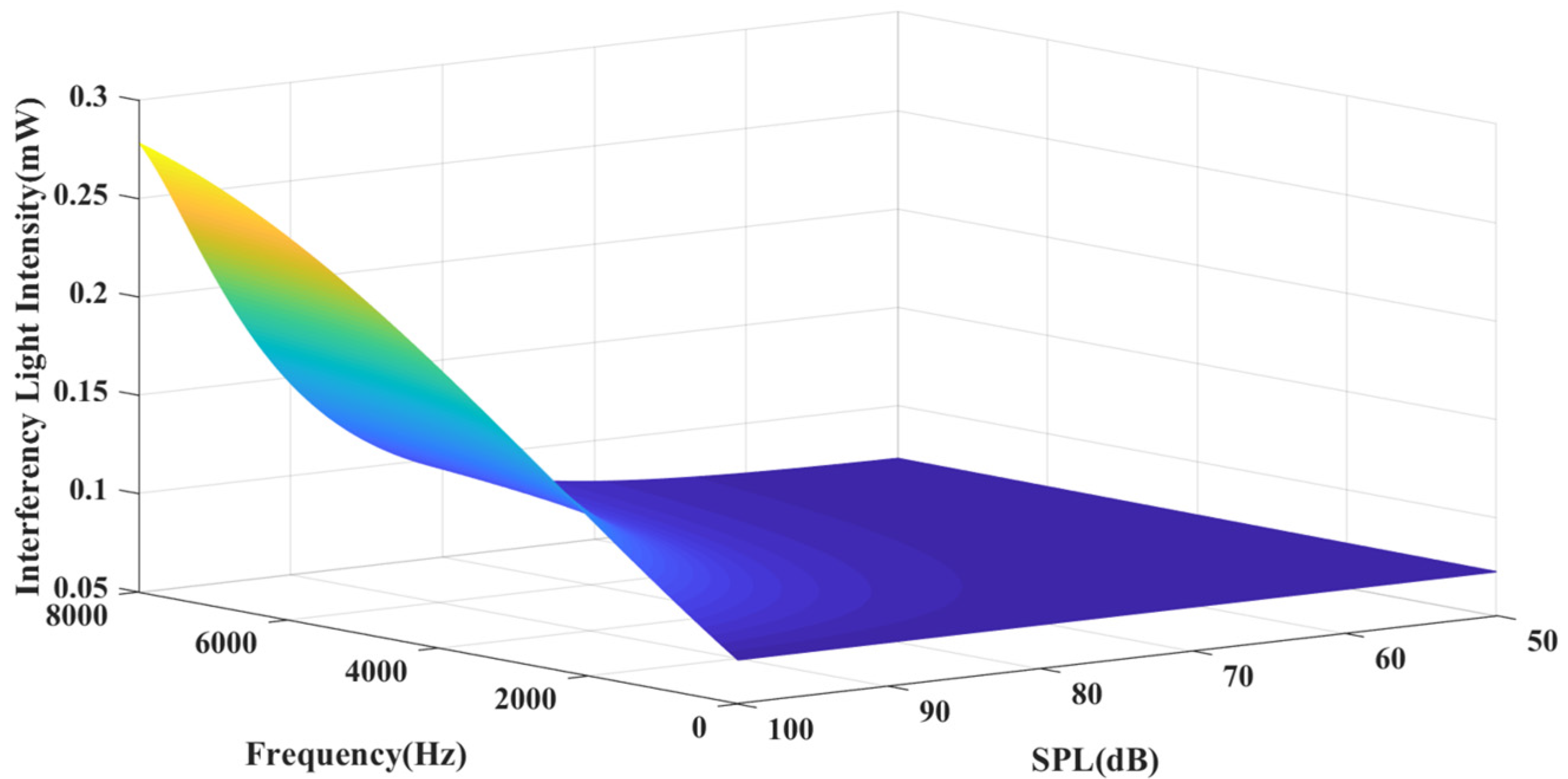
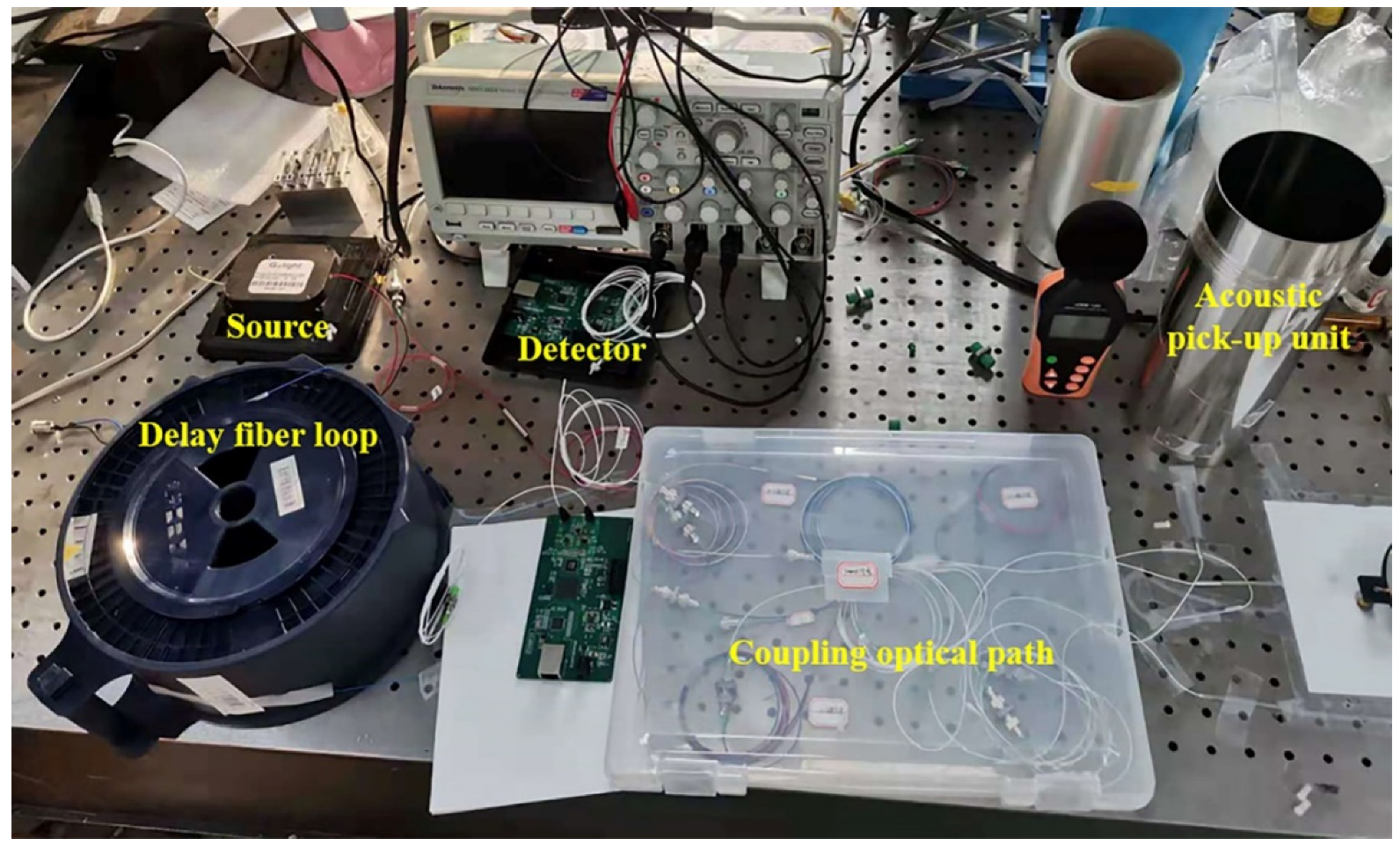
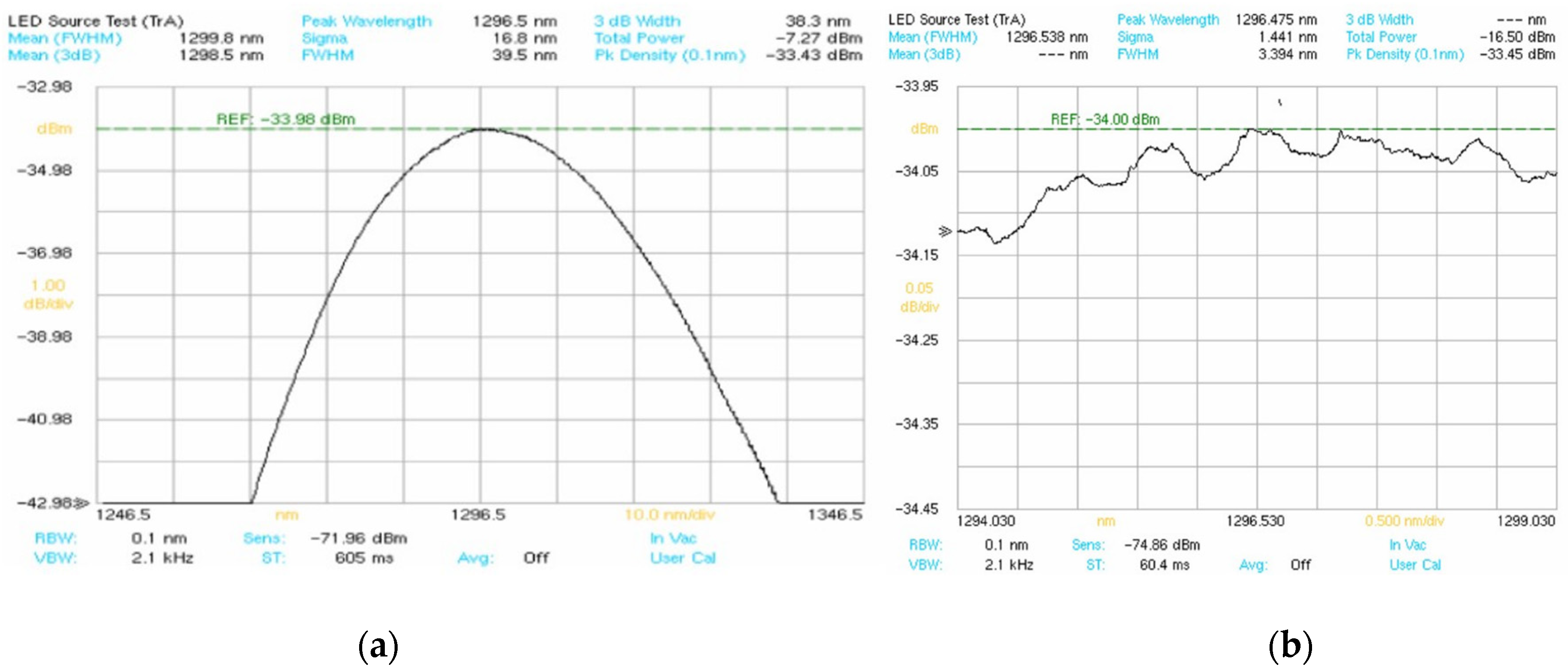
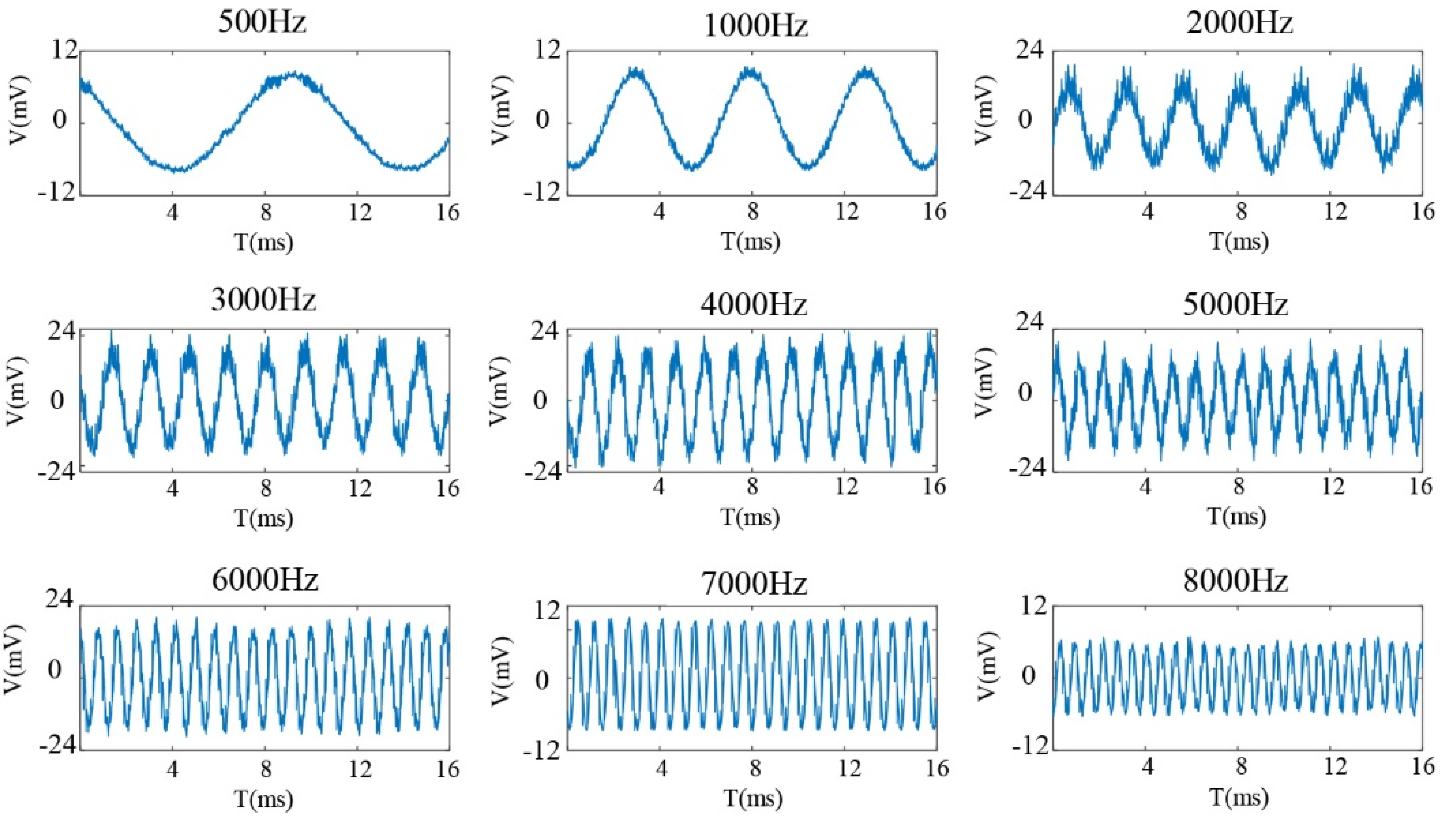

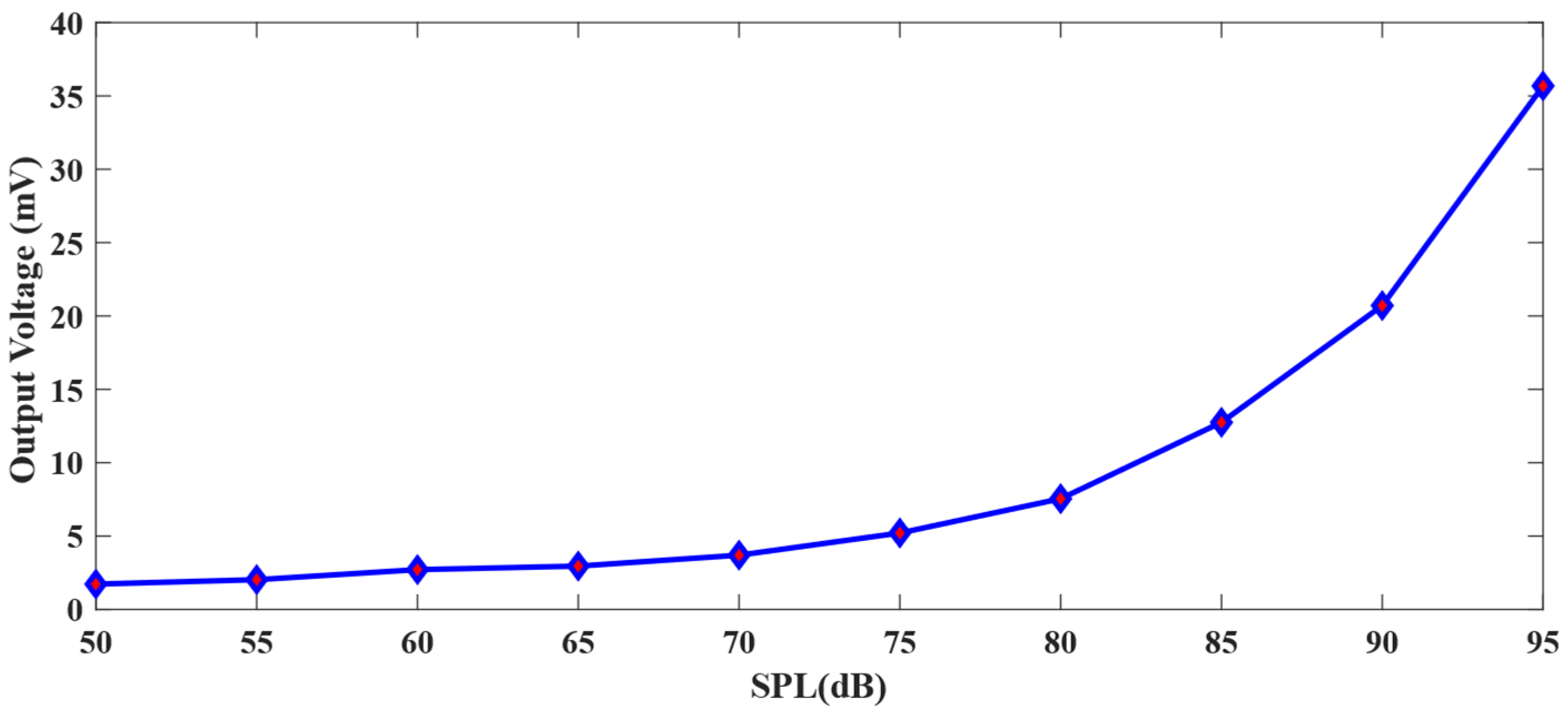
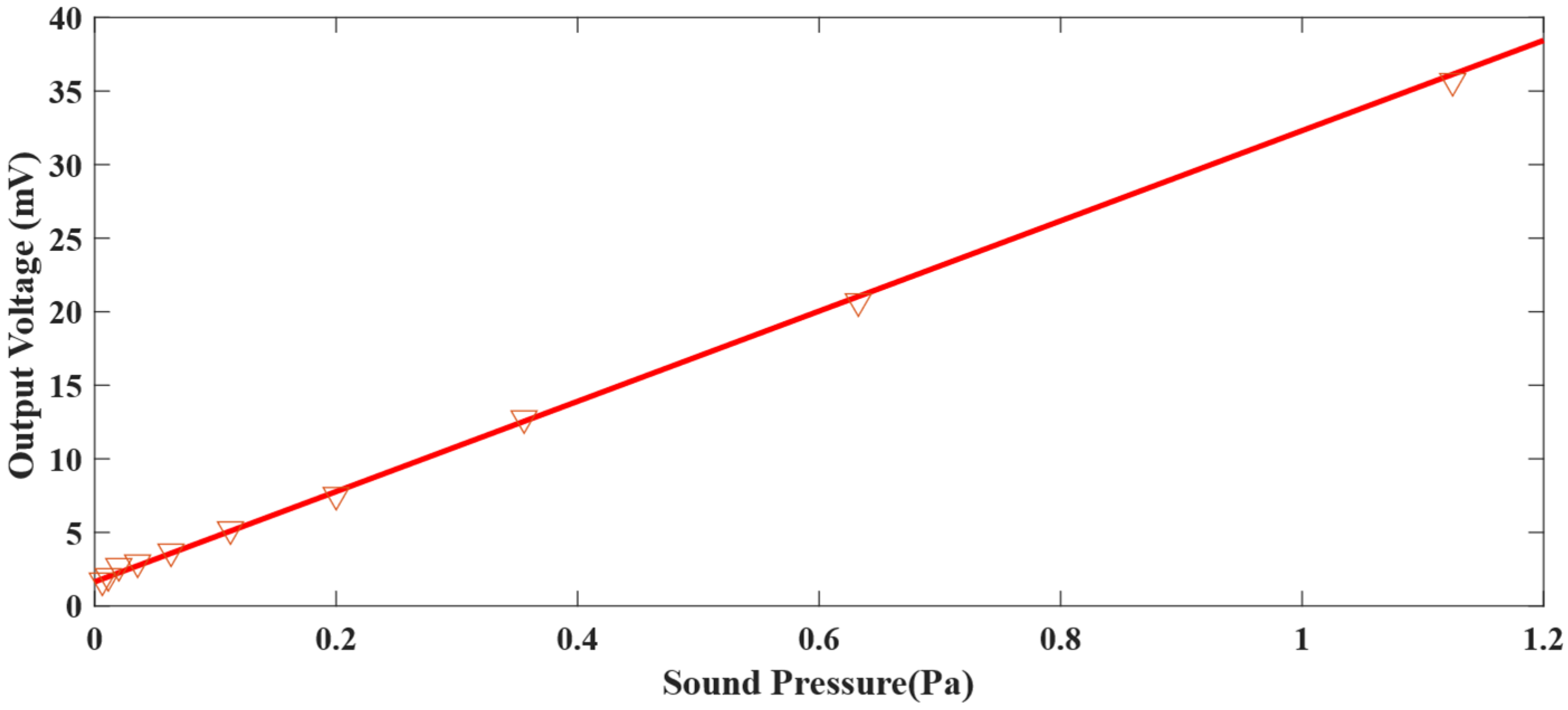
| SLD | PD | DAQ |
|---|---|---|
| Model: GR1346Q-A Central wavelength: 1296.5 nm Radiation power, ≥1 mW FWHM:Typ = 35 nm | model: GT322D Spectral Response Range:900–1700 nm Responsivity: 0.7 A/w at 1310 nm −3 dB bandwidth: ≥1500 MHz | Type: UDP communication Sampling Frequency:50 MHz Sampling Time: 16 ms |
| SPL(dB) | 50 | 55 | 60 | 65 | 70 | 75 | 80 | 85 | 90 | 95 |
|---|---|---|---|---|---|---|---|---|---|---|
| Sound Pressure (Pa) | 0.0063 | 0.011 | 0.02 | 0.036 | 0.063 | 0.11 | 0.2 | 0.36 | 0.63 | 2 |
| Data Points Number | 171 | 201 | 269 | 293 | 367 | 517 | 749 | 1266 | 2056 | 3543 |
| Output Voltage (mV) | 1.72 | 1.97 | 2.58 | 2.73 | 3.51 | 5.07 | 7.54 | 12.56 | 20.99 | 35.87 |
Disclaimer/Publisher’s Note: The statements, opinions and data contained in all publications are solely those of the individual author(s) and contributor(s) and not of MDPI and/or the editor(s). MDPI and/or the editor(s) disclaim responsibility for any injury to people or property resulting from any ideas, methods, instructions or products referred to in the content. |
© 2023 by the authors. Licensee MDPI, Basel, Switzerland. This article is an open access article distributed under the terms and conditions of the Creative Commons Attribution (CC BY) license (https://creativecommons.org/licenses/by/4.0/).
Share and Cite
Wang, J.; Tang, R.; Chen, J.; Wang, N.; Zhu, Y.; Zhang, J.; Ruan, J. Study of Straight-Line-Type Sagnac Optical Fiber Acoustic Sensing System. Photonics 2023, 10, 83. https://doi.org/10.3390/photonics10010083
Wang J, Tang R, Chen J, Wang N, Zhu Y, Zhang J, Ruan J. Study of Straight-Line-Type Sagnac Optical Fiber Acoustic Sensing System. Photonics. 2023; 10(1):83. https://doi.org/10.3390/photonics10010083
Chicago/Turabian StyleWang, Jiang, Ruixi Tang, Jianjun Chen, Ning Wang, Yong Zhu, Jie Zhang, and Juan Ruan. 2023. "Study of Straight-Line-Type Sagnac Optical Fiber Acoustic Sensing System" Photonics 10, no. 1: 83. https://doi.org/10.3390/photonics10010083
APA StyleWang, J., Tang, R., Chen, J., Wang, N., Zhu, Y., Zhang, J., & Ruan, J. (2023). Study of Straight-Line-Type Sagnac Optical Fiber Acoustic Sensing System. Photonics, 10(1), 83. https://doi.org/10.3390/photonics10010083





